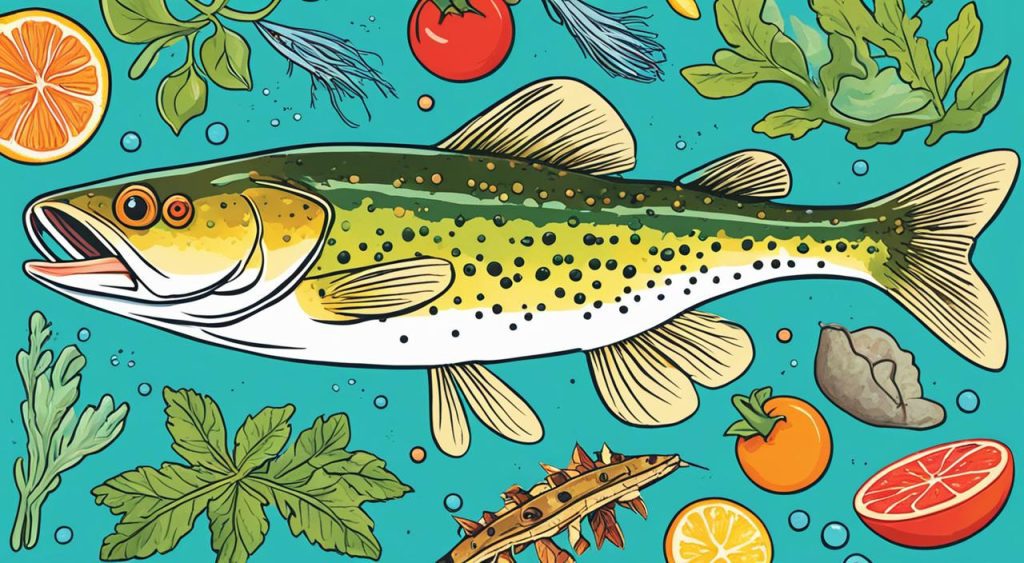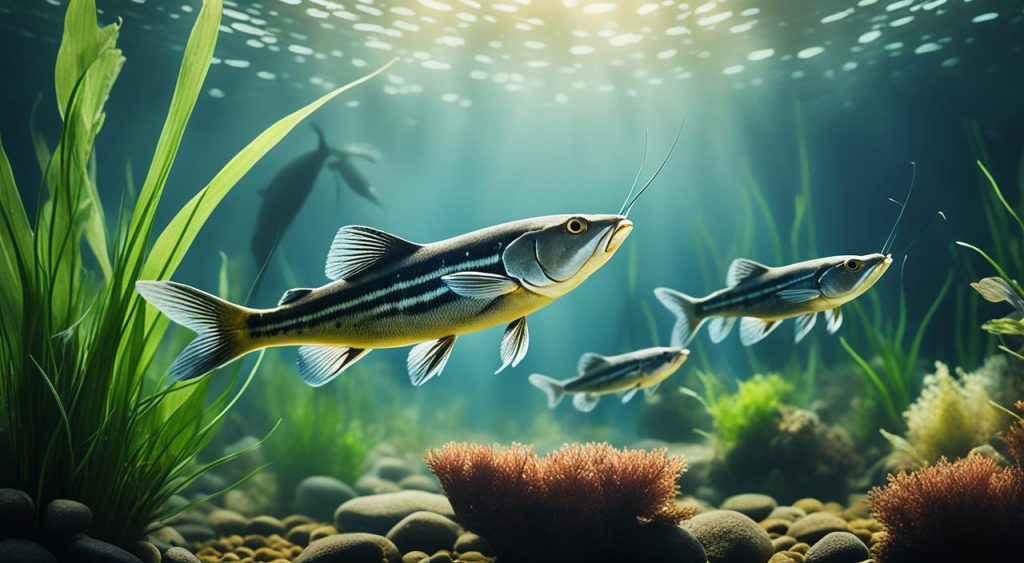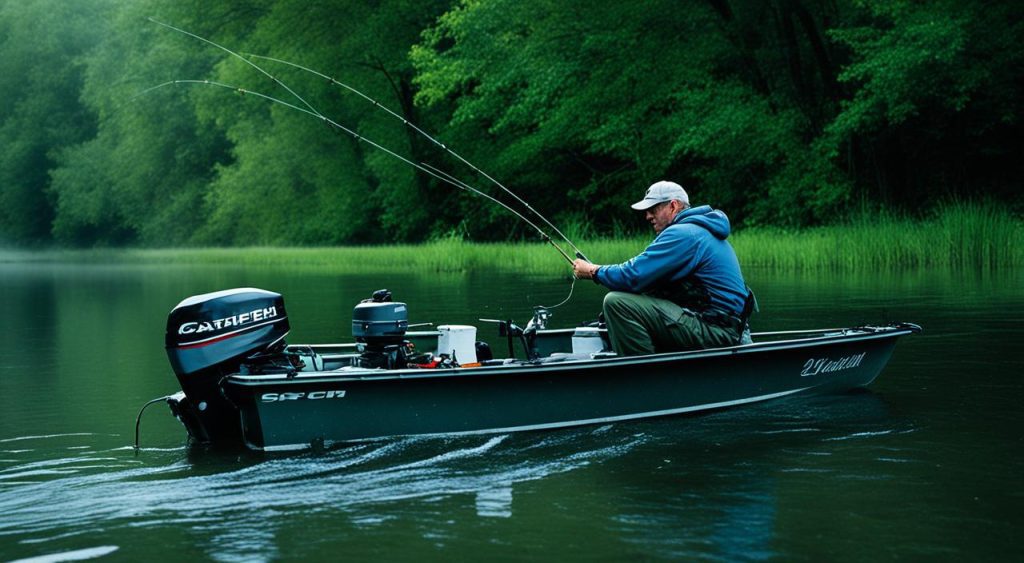Exploring the world of Catfish reveals their amazing diversity and adaptability. These fish live in freshwater all over the world. They come in many shapes, sizes, and have special senses.
Their whisker-like barbels are packed with taste buds and smell receptors. This helps them find food in murky water. They eat everything from plants and seeds to fish and small mammals.
Catfish live on almost every continent, except Antarctica. They thrive in rivers, lakes, ponds, and by the coast. Their ability to adapt to different habitats is amazing.
They range from the huge Mekong Giant Catfish to the small Corydoras. These fish are important in their ecosystems. They help keep the balance by eating both prey and leftovers.
As I learn more about catfish, I’m amazed by their special senses. Their barbels help them find food in dark water. They can even feel the tiny electrical signals from their prey.
What Are Catfish?
Catfish are fascinating fish that belong to the order Siluriformes. They are known for their whisker-like barbels. These barbels help them find food in murky waters. There are over 3,000 known species of catfish, found on every continent except Antarctica.
They live in a variety of freshwater places, from shallow ponds to deep rivers. Some even live in saltwater. This shows how adaptable they are.
Diverse and Widespread Family of Fish
The catfish family is found all over the world. They come in many sizes and shapes. The Mekong giant catfish can weigh up to 650 pounds, while the dwarf catfish is just an inch or two long.
These fish live in many freshwater places. This includes lakes, rivers, streams, and some coastal areas.
Distinctive Barbels and Sensory Adaptations
Catfish have whisker-like barbels that are very special. These barbels help them sense their surroundings. They have taste buds and chemoreceptors on them.
This lets catfish find food even when it’s hard to see. It helps them live in different kinds of water, from murky rivers to dark caves.
| Catfish Family Characteristics | Description |
|---|---|
| Order | Siluriformes |
| Distinctive Features | Whisker-like barbels, sensory adaptations |
| Habitat | Freshwater and saltwater environments |
| Diversity | Over 3,000 known species worldwide |
“Catfish are truly remarkable creatures, with a diverse array of species found in every corner of the globe. Their unique sensory adaptations and whisker-like barbels have allowed them to thrive in a wide range of aquatic habitats, making them a captivating subject for exploration and study.”
Catfish Habitats and Distribution
Catfish are a diverse and adaptable fish family, living in freshwater all over the world. They can be found in rivers, lakes, ponds, and coastal areas. Almost every continent has them, except Antarctica.
Thriving in Freshwater Environments Worldwide
There are over 2,900 catfish species in about 35 families. Most live in freshwater, with a few in saltwater. They live in many types of water, from slow to fast streams.
From Rivers to Ponds, Lakes to Coastal Regions
Catfish can live in many types of freshwater places. They are often found in rivers, ponds, lakes, and some coastal areas. Most are bottom-dwellers that are active at night. They have special senses to help them move through their environments.
| Habitat Type | Catfish Species Examples |
|---|---|
| Rivers | Channel Catfish, Blue Catfish, Wels Catfish |
| Ponds and Lakes | Corydoras, Synodontis, Clarias |
| Coastal Regions | Sea Catfish, Hardhead Catfish |
Catfish live in many places around the world, showing how well they adapt and survive. They are a key part of many aquatic ecosystems.

“Catfishes have an incredible ability to thrive in a wide range of freshwater environments, from serene ponds to swift-flowing rivers. Their adaptability is truly remarkable.”
The Omnivorous Diet of Cat Fish
Catfish are incredibly flexible in what they eat. They are mostly omnivorous bottom feeders. They eat a wide variety of foods in their homes under the water. This includes plants, seeds, fish, mollusks, insects, small mammals, and birds.
Bottom Feeders and Scavengers
Catfish are great at being both hunters and scavengers. They use their strong smell and taste to find food. This helps them live off the bottom of the water, where they find food and help control the number of other animals.
Keen Senses Guide Their Feeding Habits
- Catfish use their special senses, like barbels and taste buds, to find food.
- They have different ways of eating, like hunting alone, shoveling, eating at the surface, and feeding with others, based on what’s available.
- They can eat both from the bottom and at the water’s surface, especially in ponds.
Catfish eat a lot of different foods, making them important in their ecosystems. They help keep the balance by eating plants and small animals. This shows how important they are to the health of freshwater habitats.

Reproduction and Life Cycle
Catfish have many ways to reproduce, making them fascinating. They breed in late spring and early summer. Females lay thousands of eggs in hidden spots like rock crevices or dense plants. The male catfish guards the eggs until they hatch, which takes 5 to 10 days.
Did you know catfish can weigh from 0.9 to 1.8 kg and be 36 to 53 cm long? They can have anywhere from 3,000 to 50,000 eggs. The eggs hatch in 4 to 10 days.
Catfish can live up to 40 years in the wild. On average, they live about 14 years in the wild and up to 16 years in captivity. Their lifespan depends on things like predators, their environment, and food availability.
Catfish become ready to reproduce at about 2 to 3 years old, both males and females. This helps keep their populations healthy in their homes in the water.
| Characteristic | Value |
|---|---|
| Average mass | 0.9-1.8 kg |
| Average length | 36 to 53 cm |
| Range number of offspring | 3,000 to 50,000 |
| Range time to hatching | 4 to 10 days |
| Range time to independence | 0.5 to 4 weeks |
| Average age at sexual or reproductive maturity (female) | 2 to 3 years |
| Average age at sexual or reproductive maturity (male) | 2 to 3 years |
| Range lifespan (wild) | Up to 40 years |
| Average lifespan (wild) | 14 years |
| Average lifespan (captivity) | 16 years |
Catfish breed in the summer, from May through July. This lets their babies grow before winter.

Mississippi is a big player in catfish farming, with 35,100 acres of farms in 2021. These farms sold about $226 million worth of catfish. Over 70% of U.S. catfish comes from Mississippi, mainly in the Delta and East-Central regions.
The life cycle of catfish is amazing. It shows how resilient and adaptable they are. They play a big role in the health of our water ecosystems.
Catfish and Human Interaction
Catfish are fascinating creatures that live in water and are loved by many people. They are popular among anglers and are important in many cuisines around the world. This shows how catfish connect with humans in many ways.
Popular for Angling and Aquaculture
Catfish are a favorite among anglers for their strong fights and interesting looks. In the U.S., the channel catfish is the main type farmed for food. This makes catfish a big part of the country’s farming of fish for food.
Culinary Significance Around the World
Catfish are known for their great taste and are a key part of many dishes worldwide. They are loved in the Southern U.S. and Southeast Asia for their rich flavor. Whether cooked in many ways, catfish is a big part of food cultures everywhere, making people happy with its taste.
| Region | Signature Catfish Dishes |
|---|---|
| Southern United States | Fried catfish, catfish po’ boys, blackened catfish |
| Southeast Asia | Catfish curry, grilled catfish, catfish stew |
| West Africa | Catfish stew, smoked catfish, catfish in palm oil |
Catfish also attract anglers and fish keepers with their strong fights and interesting looks. They are loved for their unique behaviors and features.

“Catching a big catfish is like reeling in a piece of the river itself – a primal, powerful experience that connects you to the aquatic world in a profound way.”
The bond between catfish and humans is strong. It’s seen in the excitement of catching a big catfish or enjoying its tasty meat. This connection has been important to us for a long time and still inspires us today.
Conservation Status and Threats
Many catfish species do well in water around the world. But, some face big challenges in conservation. These endangered and vulnerable catfish are threatened by overfishing, losing their homes, and pollution.
Endangered Giants and Vulnerable Species
The Mekong Giant Catfish is in big trouble, with its numbers dropping by 30% in 15 years. These huge fish are under special protection, but their homes are being destroyed fast. The fishing cat is also at risk, with fewer than 10,000 left in Asia due to roads and losing its home.
There are efforts to save these catfish and their homes. In Cambodia, cameras showed fishing cats are still around, proving they weren’t extinct. But, we need to do more as their homes are being destroyed for other uses.
People see catfish as important for protecting wetlands. Saving these fish helps keep our waterways healthy. We must work harder to protect these amazing creatures.
“Catfish are not just fascinating creatures; they are barometers of the health of our aquatic ecosystems. Protecting them means safeguarding the delicate balance of our waterways for generations to come.”
Sensory Superpowers of Catfish
Catfish may not have the shiny scales of a salmon or the sharp eyes of a trout. But they have special senses that help them live well in the water. Their barbels, or “whiskers,” are full of taste buds and sensors. This lets them move through murky water, find food, and talk to other catfish.
The Power of Whiskers (Barbels)
Catfish have up to 175,000 taste-sensitive cells in their bodies, much more than humans with 10,000. Their barbels, up to eight around the mouth, are full of taste receptors. This means they can feel even tiny changes in the water. They can detect food and nutrients at very low levels, sensing one molecule in 10 billion parts of water.
Beyond Sight: Electroreception and Taste
Some catfish, like the Electric Catfish, have an amazing sense called electroreception. They can feel the weak electrical signals from other animals. This helps them “see” in the dark and find food very precisely. They also have taste buds all over their bodies. This helps them know what’s around them and find food even when it’s hard to see.
“Catfish can taste with their entire bodies and sense the direction of taste.”
With their sensitive barbels, electroreception, and taste receptors, catfish are experts under water. These abilities let them live in very murky waters. They are great hunters and scavengers in the water.
Predators and Scavengers of the Aquatic Realm
Catfish are key to keeping aquatic ecosystems healthy. They act as both predators and scavengers. As top predators, they eat a wide variety of prey, like invertebrates, smaller fish, and small mammals. This helps keep the food web balanced, stopping any one species from taking over.
Catfish also clean up the aquatic environment. They eat dead and decaying matter at the bottom of the water. This breaks down organic material and releases nutrients back into the water. This supports the overall health and productivity of the ecosystem.
Regulating Prey Populations
Catfish are great at hunting, using their senses and hunting skills to catch different prey. They eat invertebrates, small fish, and even small mammals. This helps control the numbers of their prey, keeping the food web balanced. This balance lets many species live together and keeps the ecosystem stable.
Nature’s Cleanup Crew
Catfish also act as scavengers, eating dead and decaying matter at the water’s bottom. This process of nutrient cycling is vital for the ecosystem. It releases nutrients back into the water, helping other aquatic life grow and thrive.
| Ecosystem Service | Importance |
|---|---|
| Prey Population Regulation | Maintains balance in the food web, preventing any single species from dominating |
| Nutrient Cycling | Releases essential nutrients back into the water column, promoting ecosystem productivity |
Catfish play a vital role in aquatic ecosystems. They regulate prey populations, cycle nutrients, and ensure the health and stability of their environments. They are truly the stewards of aquatic ecosystems.
Sculpting Aquatic Ecosystems
Catfish do more than just control prey and clean up the environment. They shape the ecosystems they live in. While foraging, they stir up the bottom, releasing nutrients back into the water. This helps phytoplankton grow, which is key to the food web.
They also make the habitat more diverse by disturbing the substrate. This helps other creatures that live on the bottom. Scientists watch catfish to understand how healthy an aquatic ecosystem is and spot problems early.
Nutrient Cycling and Habitat Creation
Catfish do more than just cycle nutrients and create habitats. They aerate the soil as they move, boosting oxygen levels and helping good microorganisms grow. This makes the ecosystem health better, supporting many aquatic species.
- Catfish are key in ecosystem engineering, helping with nutrient cycling and habitat creation.
- Their actions release nutrients, helping phytoplankton grow and supporting the food web.
- They make a better habitat for many aquatic species, making ecosystems more diverse and resilient.
- Watching catfish helps scientists understand the health of aquatic ecosystems and find environmental issues.
“The catfishes in the Momentary exhibition are not just captivating creatures; they are living, breathing examples of the pivotal role that these remarkable fish play in shaping and sustaining the delicate balance of aquatic ecosystems.”
The Allure of Catfishing
Catfish are known for their unique whiskers and interesting behaviors. They are a favorite among anglers and those who keep fish in tanks. Catfish offer a fun challenge for people of all fishing skills. From the easy-to-catch Channel Catfish to the rare Mekong Giant Catfish, there’s a catfish for every catfish angling fan.
Catfish also catch the eye of those who keep fish tanks. Their special looks and interesting catfish behavior make them great catfish aquarium pets. They bring a sense of wonder and interest to any tank.
A Thrilling Catch for Anglers
Anglers find catfish angling exciting, whether it’s fighting a Channel Catfish or chasing a Mekong Giant Catfish. These fish are strong and put up a great fight. They test the skills and patience of even the best fishermen.
Captivating Aquarium Inhabitants
For those who love aquariums, catfish are a great choice. Their unique looks, like their whisker-like barbels, and interesting catfish behavior make them popular. They add a special touch to any tank.
“Catfish are truly the ultimate aquatic companions, captivating us with their unique allure and unparalleled appeal.”
Diversity in the Catfish Kingdom
When you think of catfish, you might picture a fish with whiskers that lives on the bottom of the river. But the truth is, catfish are much more diverse and interesting. They belong to the order Siluriformes and show how creative evolution can be.
There are over 3,000 known species of catfish. Each one has its own unique shape, size, and way of living in the water. You can find everything from the Channel Catfish and Corydoras Catfish to the Electric Catfish and the huge Mekong Giant Catfish. These fish are a perfect example of how diverse and creative nature can be.
Catfish have been able to adapt and succeed in many different types of water around the world. They make up about 10.8% of all fish and 5.5% of all vertebrates. You can find them from the neotropics of South America to the hill-streams of South Asia. Each catfish species is perfectly suited to its own environment.
There are many different types of catfish, like the air-breathing Clariidae from Africa, the electric Malapteruridae, and the thorny Doradidae from South America. This variety shows how amazing nature is at creating different species that can live in various places.
FAQ
What are catfish?
Catfish are a group of fish that live in fresh and some brackish water. They are known for their whisker-like barbels. They belong to the order Siluriformes and vary in shape, size, and adaptations.
Where can catfish be found?
Catfish live on every continent except Antarctica. They thrive in freshwater places like rivers, lakes, ponds, and some coastal areas.
What do catfish eat?
Catfish eat a mix of plants, seeds, fish, mollusks, insects, and small mammals and birds. They are omnivorous bottom feeders.
How do catfish reproduce?
Catfish breed in late spring and early summer. Females lay thousands of eggs in hidden spots. Males guard the eggs until they hatch.
What is the significance of catfish for humans?
Catfish are loved by anglers and farmed for food. They are tasty and popular worldwide. Aquarists also appreciate their unique looks and behaviors.
What are the threats to catfish populations?
Some catfish species face threats from overfishing and pollution. Efforts are underway to protect them and their homes.
What are the unique adaptations of catfish?
Catfish have special senses to navigate murky waters and find food. They use their barbels and electroreception. They also have taste buds all over their bodies.
How do catfish contribute to aquatic ecosystems?
Catfish are key to healthy aquatic ecosystems. They eat prey and recycle nutrients, keeping the ecosystem balanced and productive.
What is the appeal of catfish for anglers and aquarists?
Anglers enjoy the challenge of catching catfish. Aquarists like their unique looks and behaviors, adding fun to aquariums.




